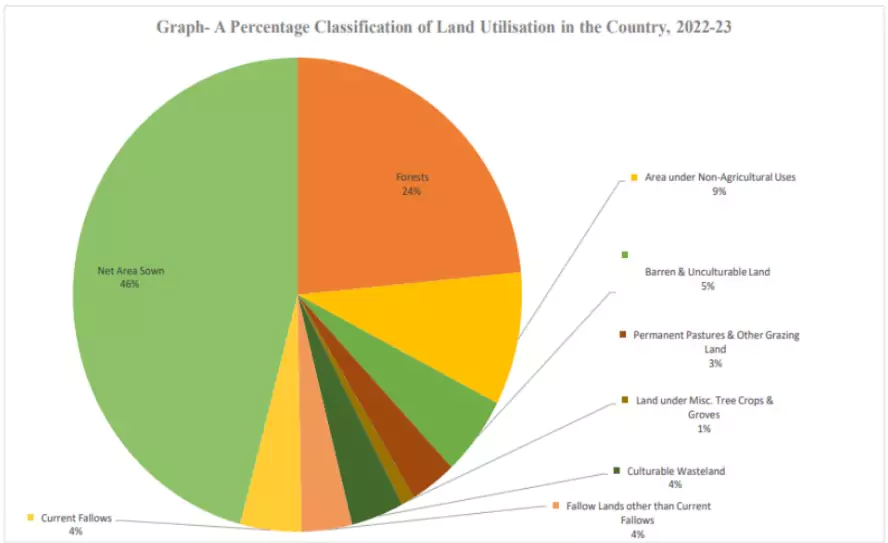Environmentalists raising concern about India’s open ecosystems (deserts, grasslands, scrublands, and savannas) have long been viewed as degraded barren lands and urged policymakers to recognize its importance to ensure their conservation and sustainable management.
What are Open Ecosystems?
- Definition: Open ecosystems refer to natural landscapes that are minimally disturbed by human activities and exhibit a high degree of species diversity and resilience. They include:
- Deserts: Nearly one-third of Earth’s surface, home to specialized plant and animal species.
- Grasslands & Savannas: Vast open landscapes rich in biodiversity, supporting both flora and fauna adapted to arid and semi-arid conditions.
- Scrublands: Transitional ecosystems that bridge deserts and more humid regions, important for biodiversity.
Importance of Open System
- Biodiversity Hotspots: For example, the Thar Desert supports endemic species like the Chinkara and the Desert Fox.
- Unique species such as the Great Indian Bustard, Indian wolf, and Caracal depend on these ecosystems.
- Carbon Sequestration: These ecosystems store significant carbon in the soil, reducing the impact of climate change.
- Grasslands can store up to 5–10 times more carbon per hectare than tropical forests, as demonstrated by IPCC 2023 reports.
- For instance, grasslands store carbon in deep soil, making them important carbon sinks.
- Livelihoods: Pastoral communities like the Dhangar, Rabari, and Kuruba rely on these open ecosystems for grazing lands.
- As per the National Bureau of Animal Genetic Resources (NBAGR), over 80 million pastoralists in India depend on these ecosystems for their livelihood.
- Their migration patterns and grazing methods often contribute to ecosystem health and biodiversity conservation.
- Historical Role in Civilizations: Early civilizations, including those in Mesopotamia, Egypt, and the Indus Valley, were established in desert climates.
- The harsh conditions prompted the creation of innovative irrigation systems and advanced water management techniques, enabling these civilizations to thrive.
Challenges in India with Their Classification
- Colonial Legacy: The term “wasteland” was introduced during British colonial rule to classify lands that were deemed unproductive. Even today, millions of hectares of deserts, grasslands, and savannas are marked as “wastelands” on official maps.
- Example: The Kutch region in Gujarat, classified as wasteland, is a crucial habitat for migratory birds and the endangered Indian Wild Ass.
- Misguided Interventions:
- Afforestation and Agriculture: Policies aimed at transforming these areas often involve large-scale afforestation or conversion into agricultural land, which can be unsustainable.
- For instance, attempts to convert desert areas into agricultural zones often fail due to water scarcity and unsuited soil conditions.
- Fencing and Urbanization: Converting grasslands into urban areas or fencing off traditional grazing grounds disrupts local biodiversity and pastoralist lifestyles.
- An example is the Sultanpur National Park in Haryana, where fencing has restricted pastoralist access, causing conflict between conservation and livelihoods.
- Lack of Policy Focus:
- Absence of Protection for Pastoral Systems: While wildlife sanctuaries exist, pastoralist grazing lands often lack legal protection, leading to land degradation and loss of livelihoods for these communities.
- For example, in Himachal Pradesh, about 65% of the land is already under forest or protected areas.
Classification of Land Use in India
- India follows a nine-fold classification for land use statistics, which is systematically recorded on an annual basis.
- This classification covers a reporting area of 305 million hectares out of the total geographical area of 329 million hectares. The remaining 7% of the area is considered non-reporting, which includes some areas that cannot be classified under the nine-fold system.
- Forests: This includes all land recognized as forest under legal enactments or administratively designated as forest. It includes both state-owned and private forests, and whether they are wooded or maintained as potential forest land.
- It also covers areas where crops are raised within forest areas, as well as grazing lands or areas open for grazing.
- Area under Non-Agricultural Uses: This category encompasses all lands occupied by buildings, roads, railways, water bodies like rivers, canals, lakes, and other non-agricultural uses.
- Barren and Un-culturable Land: Land that cannot be brought under cultivation due to natural conditions or at an exorbitant cost. This includes mountains, deserts, and rocky land.
- It also includes deserts or any land that is unsuitable for agriculture.
- Permanent Pastures and Other Grazing Lands: This category includes all grazing lands, whether they are permanent pastures, meadows, or village common grazing lands.
- These lands may or may not be fenced, but they are generally used for livestock grazing.
- Land under Miscellaneous Tree Crops, etc.: This category includes cultivable land that is not classified as “Net Area Sown” but is put to some agricultural use. It includes land under tree crops like casurina, bamboo, thatching grasses, and other fuelwood groves.
- These lands do not fall under traditional orchards but still serve agricultural or commercial purposes.
- Culturable Waste Land: Lands that are available for cultivation but have not been utilized for a while. These lands may either be fallow or covered with shrubs or jungle, often left unused due to various reasons such as soil degradation, water scarcity, or lack of proper irrigation.
- These lands have the potential for rehabilitation and can be brought under cultivation.
- Fallow Lands Other than Current Fallows: This includes lands that were cultivated previously but are temporarily out of cultivation for a period of one to five years.
- These lands are in a state of temporary fallow, where the land is not actively used for growing crops, often due to the natural resting phase required for soil rejuvenation.
- Current Fallows: This represents cropped land that is kept fallow during the current year. For example, a sown area that remains uncultivated due to factors like monsoon failure, lack of irrigation, or crop rotation.
- These areas are considered fallow for that particular cropping season.
- Net Area Sown: This refers to the total area that has been sown with crops during the year. The area is counted only once even if it is used for multiple sowings during the year.
- This category includes cropped areas, including both food crops and cash crops, as well as orchards.

|
Way Forward
- Reclassify and Reinterpret Open Ecosystems: Replace the term “wasteland” with more accurate descriptors like grasslands, savannas, and deserts, which recognize their ecological value.
- Example: Instead of “greening” deserts, policymakers could focus on conservation-based restoration practices, focusing on natural vegetation and soil moisture conservation.
- Integrate Indigenous Knowledge and Practices: Acknowledge the traditional knowledge of pastoral communities and integrate practices like rotational grazing and water harvesting into national policies.
- Example: The Rajasthan State Government can incorporate pastoral land management practices into its ecosystem restoration programs, ensuring that both biodiversity and livelihoods are protected.
- Support Low-Tech Restoration: Shift focus from high-tech interventions like monoculture plantations to low-tech restoration methods such as protecting natural regrowth, soil conservation, and water harvesting.
- Example: Rotational grazing systems used by pastoralist communities, such as the Rabari in Gujarat, should be promoted as an alternative to industrial-scale land reclamation projects.
- Recognize the Role of Pastoralists: Legalize and protect pastoral grazing rights in open ecosystems, ensuring that communities are not excluded from the land they have stewarded for centuries.
- Example: The Gujjar and Bakarwal communities in Jammu and Kashmir have faced conflicts over land ownership and grazing rights.
- Policies should protect their right to mobility and grazing, ensuring the health of both the land and the people.
- Promote Public Awareness: Launch public awareness campaigns to reframe the narrative surrounding open ecosystems, highlighting their role in carbon sequestration, biodiversity conservation, and rural livelihoods.
- Example: Renaming the World Day to Combat Desertification and Drought to “World Day to Combat Land Degradation”, to acknowledge the ecological legitimacy of deserts and grasslands.
Conclusion
India’s open ecosystems, deserts, grasslands, scrublands, and savannas—hold immense ecological and social value. They support unique biodiversity, store carbon, and provide vital livelihoods to millions of people.
- By reclassifying these lands, integrating indigenous knowledge, and promoting sustainable restoration practices, India can ensure that these ecosystems continue to thrive for future generations.
![]() 14 Jul 2025
14 Jul 2025

